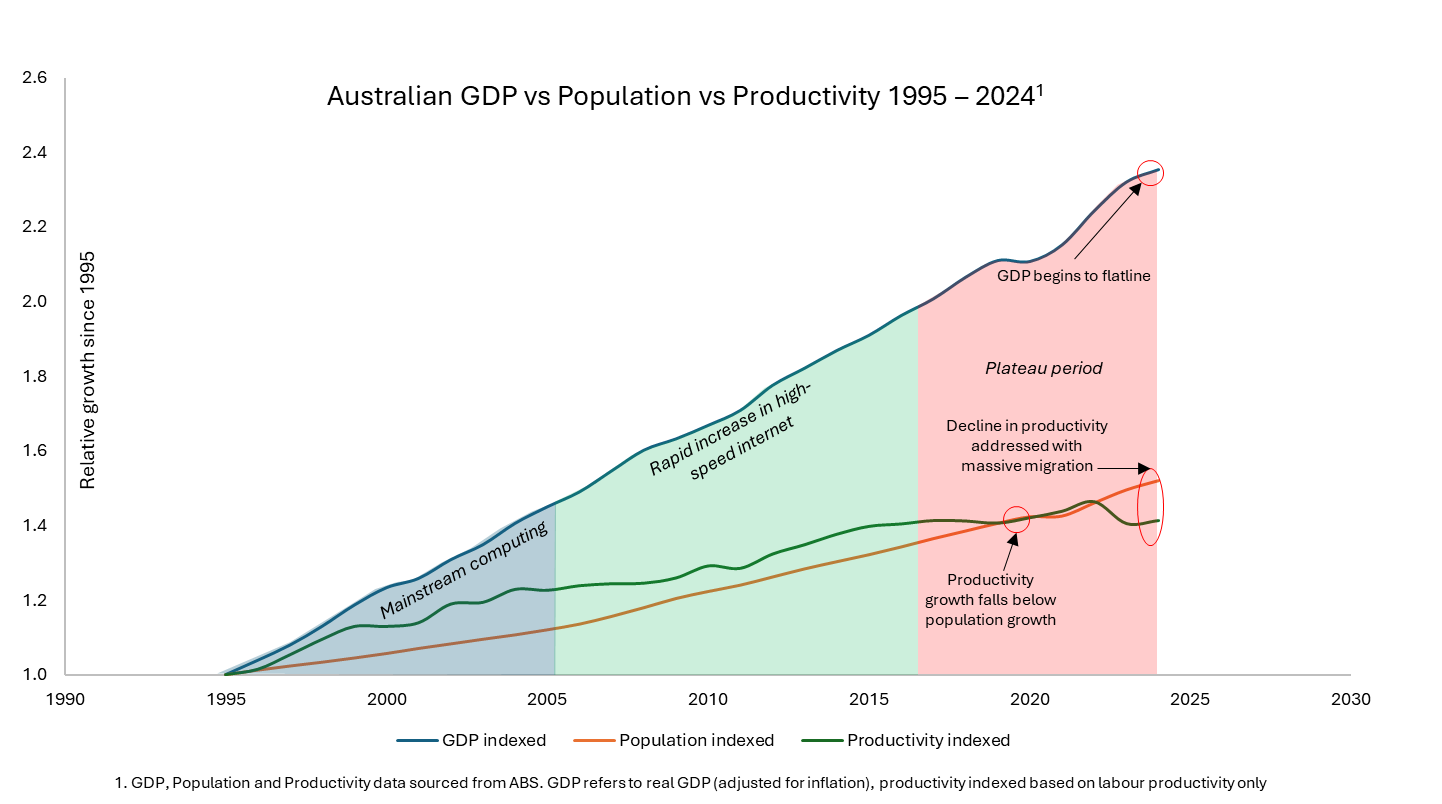Most western economies have become used to endless economic growth throughout most of the 20th and 21st centuries. However, this growth is not a given. It requires both innovation and population growth and recent economic indicators suggest we may be coming to a dead end. With population growth stagnating or even reversing in developed nations, the onus is now firmly on productivity gains to drive long-term economic expansion. Whilst there is an understandable amount of fearmongering around the emergence of AI, it may be the silver bullet we need.
The emergence of artificial intelligence (AI) stands out as the most transformative force since the dawn of the internet. In this context, AI is not merely a technological advancement—it is a macroeconomic necessity for us to continue enjoying the life of endless growth that we currently know.
At its most fundamental level, GDP growth can be broken down into two drivers: population growth and productivity growth. For much of the 20th century, these two factors worked in tandem to support expanding economies. The Industrial Revolution sparked massive gains in production and efficiency. Later, the advent of computers and then the internet unlocked new layers of coordination, speed, and scalability across sectors. These breakthroughs fuelled decades of economic dynamism, from manufacturing booms to the rise of the digital economy.
However, the demographic tailwinds that once powered the global economy are dissipating. Countries across the West—particularly Australia, Japan, Germany, Italy, and now even the United States—are experiencing low birth rates and aging populations. To add to this, the productivity gains experienced from digitisation and rapid internet communications have likely reached their peak. We are now facing a situation where both population growth and productivity have stalled, and real GDP growth is hard to find.
Taking a look closer to home, specifically in Australia, we can see these factors playing out. Between 1995 and 2015 Australia enjoyed consistent (aside from dot-com bubble and GFC) real GDP growth of between 2% and 5% per year. Population growth was 1% - 2% and productivity growth was 2% - 3%. We were getting bigger and more efficient for two decades. Approaching 2020, productivity started to flat line and since COVID productivity has even gone backwards.
Amazingly, for the first time in living memory, population growth (driven by migration) exceeds productivity growth. Consequently, GDP growth is now flatlining and without massive net migration (which is unsustainable long term), Australia would have been in a recession. We can’t fix our birth rate quickly, we need to focus on productivity in the short term or face a tougher decade ahead.

Enter AI, the next major technological leap with the potential to redefine productivity. Unlike previous innovations, AI can autonomously perform cognitive tasks, analyse massive datasets in real time, and continually improve through machine learning. From automating customer service to optimizing supply chains and enhancing medical diagnostics, AI is unlocking new efficiencies across both blue- and white-collar domains. It promises not only incremental improvement, but exponential acceleration in output per worker—precisely what modern economies now require. AI may be the biggest driver of increased productivity, outpacing even the impact of the industrial revolution.
In terms of the impact on M&A activity, AI has the potential to drastically increase the volume of transactions. Historically, periods of significant change have triggered increased M&A activity, as companies make strategic investments to protect their core business and drive growth.
The other key driver that may boost M&A activity is AI’s ability to simplify and accelerate the due diligence process. If you think back to the early 90’s, deals were hard and slow to execute. Accounting systems were largely manual, most contracts were still paper-based and a data room was an actual physical room loaded with tonnes of documents. It took much longer to complete a business sale process and the outcome of diligence was less certain compared to today when we have access to a wide range of digital analytical tools. Whilst we are not there yet, AI has the potential to compress the due diligence process to a matter of hours, with less human resources required to complete deals. Making the process of M&A easier could rapidly drive increased deal volumes, or maybe that is the optimistic thinking of the banker in me.
The historical drivers of population growth and productivity gains have largely run their course. If we want to continue living a life of perpetual economic growth, then we need something to supercharge the next wave.
Whilst many people fear the disruption that AI may cause to the traditional economy, it may just be the solution we need to keep growing.
[download_industry_guides][/download_industry_guides]







